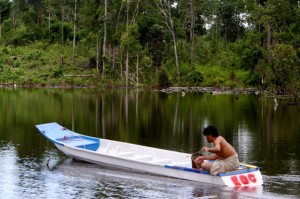New, more stable boats arrive.
Nakai District - Khammouan Province- Lao Peoples Democratic Republic
Last month I wrote about the young man who drowned in the reservoir near Nakai Tai Village. A couple of ironic events followed quickly in the aftermath of that event.
Within days of my telling readers that I avoid using village boats except as a last resort, Yai and I found ourselves on the banks of the Xe Bang Fai River with no other alternative. Rains the night before had filled the river; plastic bags hanging in tree branches just inches above the water indicated that the river was near its high water mark: too deep to wade, too swift to float across.
We felt compelled to make our way across. A fellow was waiting on the other side to show us a rocket that he’d found, and some children told us they knew the whereabouts of several cluster bombs. High water seemed like a weak excuse for stiffing the villagers, so we did as everyone along the river does; we commandeered the best of the derelict boats parked on shore. None had paddles so we cut bamboo poles to use in their place.
Then, Yai meekly confessed that we had no life jackets with us. “In the camp? A lot of good they’re going to do us there!” I scolded, unfairly pinning the blame for poor planning on him.
Surprisingly, Yai pled guilty to an offense worse than forgetfulness. He ruefully confessed that the vests weren’t in camp; they were 200 miles away in Vientiane, his having borrowed them for a family vacation.
Doing a slow, smoldering burn, I collected some empty plastic water bottles that were laying about in the hope that they would hold me afloat in the event that we tipped or swamped the boat mid-stream.
As grumpy as I was, I couldn’t think of any way to hold Yai responsible for my being at river’s edge without a waterproof bag to secure my cameras. There was no one to blame for that screw-up but myself, making me even more unforgiving about the vests. I took my cameras apart and placed the lenses, bodies and other assorted pieces in plastic bags that I found littering the ground. I comforted myself with the thought that if I drowned I wouldn’t much miss my cameras.
As usual when we are in those boats, Yai paddled furiously to fight the current and move us toward the opposing shore, while I matched him stroke for stroke with my bailing pail. I did my best but never actually got ahead of the water trickling through split boards and cracked seams. I usually wear out before Yai does, but visions of the drowned boy from Nakai Tai kept me moving until we plowed ashore.
The second irony associated with the drowning is that today, two large trucks loaded with new boats arrived for delivery to the resettled villagers. They are fiberglass, factory-made and designed with a modest keel that will give them greater stability than the old village boats. No doubt, they also have positive floatation, meaning that, even if swamped, they will stay afloat. (Unlike the wooden boat that sank under the man who drowned, leaving him to struggle unsuccessfully toward shore).
It turns out that the company that built the hydroelectric plant and is responsible for creating the reservoir had intended all along to provide villagers with new boats, better suited to open water. There is one new boat for every two families. Sadly, the boats I saw delivered today come a month too late to make a difference to the young victim from Nakai Tai.
To my surprise, the guys on our Response Team looked at the boats somewhat skeptically. They doubted whether the boats, albeit pretty today, would hold up year after year. Their common judgment was that the fiberglass boats would scratch easily and might even break apart on rocks. “And then”, they asked, “who will know how to fix them?”
I found their conservatism interesting, since the Lao have a bit of an inferiority complex and will usually show preference for things made in Thailand or Vietnam over items manufactured in their own country. (I heard that preference expressed by Lao people, as recently as just this week, in discussion of items as diverse as prescription drugs and house paint).
Was it only me, the outsider, who recognized the shortcomings of the old village boats? How could the guys find anything about their wooden boats that was preferable to the sleek, factory-built boats from Vietnam? I fought the impulse to ask sarcastically, “What’s the difference between a boat you can’t repair and a boat you don’t repair?” For once, I held my tongue.
For whatever reason the men have an affection for the old boats. I suspect that, while they know that the new boats are better suited for a changing environment, they take pride in boats that they learned to make from their fathers and grandfathers, entirely from materials they can collect in the forest that surrounds their village. Wooden boats, perhaps less seaworthy than the mass-produced, factory-built boats from Vietnam, but worthy in other ways that the guys can only feel and not explain.

